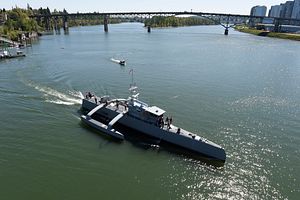The U.S. Navy plans to establish a Surface Development Squadron (SURFDEVRON) to help with the integration of future autonomous platforms like the sub-hunting robot ship Sea Hunter, in an ongoing effort to make U.S. naval surface forces more distributed and reliant on unmanned ships and aircraft, according to local media reports.
The U.S. Navy requested $400 million in the 2020 defense budget for two large unmanned surface vessels (USV), which will form the nucleus of the SURDEVRON. For the next five years, the service requested a total of $2.7 billion under the so-called Future Years Defense Program(FYDP) for two LUSVs per annum during that timeframe.
“That’s happening,” Vice Admiral Richard Brown, the head the U.S. Navy surface forces in the Pacific, was quoted by Defense News as saying in a recent interview. “We’re going to have large [unmanned surface vessels], we’re going to have medium-displacement USVs. I’ve got Sea Hunter running around. I’ve got no place to put those things. That was the impetus behind the development of the Surface Development Squadron.”
Last year, the Sea Hunter, the first prototype of the Office of Naval Research (ONR)’s Medium Unmanned Surface Vessel (MUSV), autonomously navigated from San Diego to Pearl Harbor, Hawaii. While the Sea Hunter reportedly experienced three “mechanical or electrical” issues during a transit, the mission was deemed successful. Additional tests of the platform are currently ongoing, according to USNI News. As I reported in January:
U.S. Defense Advanced Research Projects Agency (DARPA) – a Pentagon organization responsible for developing emerging technologies for the U.S. military’s use — handed over the Sea Hunter to the U.S. Navy in January 2018, marking the end of DARPA’s Anti-Submarine Warfare Continuous Trail Unmanned Vessel (ACTUV) program.
DARPA originally initiated the ACTUV program in 2010. In 2014, DARPA joined force with ONR to jointly fund a test phase for the ACTUV prototype, with Leidos building the ship’s navigation system and Oregon-based Vigor Works overseeing overall construction. The ship was christened in April 2016 and subsequently underwent open-water trials, which included testing the prototype’s long-range tracking capabilities. Tests also included tracking a submarine from 1 kilometer away, as well as deploying a mine countermeasures payload.
Additionally, as I explained in February 2018:
Capable of reaching top speeds of up 27 knots, the 132-feet (40 meters) long and 140-ton heavy unmanned autonomous MDSUV trimaran prototype is designed to operate autonomously for 60 to 90 days straight, surveil large stretches of ocean territory and — should an enemy submarine be detected — guide U.S. Navy warships or aircraft to the sub’s location to destroy it (the Sea Hunter does not carry any weapons systems).
The robot ship reportedly uses a fifth-generation medium-frequency hull-mounted sonar system to conduct active and passive sonar searches. DARPA has also been working on developing non-conventional sensor technologies to enable the correct identification of surface ships and other objects while at sea.
The new SURFDEVRON will help integrate the new platform and subsequent USVs into the surface fleet. “We’ve got to figure out command and control,” Brown told Defense News. “We’ve got to figure out the man, train and equip aspects — there’s got to be an administrative commander in charge of them, got to be a guy who equips those things, got to be a guy who oversees the training of the people who interact with and use the USVs.”
“Let’s say I have a ship going over the horizon and it has three USVs it’s operating with. I’ve got to have a ship that’s manned and trained to operate those USVs, and that ship has to be equipped with the comms architecture, and I’ve got to make sure the USVs are manned, trained and equipped,” Brown added. “Right now I don’t even know what that looks like. We are going to experiment the hell out of it in the SURFDEVRON.”
SURDEVRON is expected to be stood up before the end of the year.
































